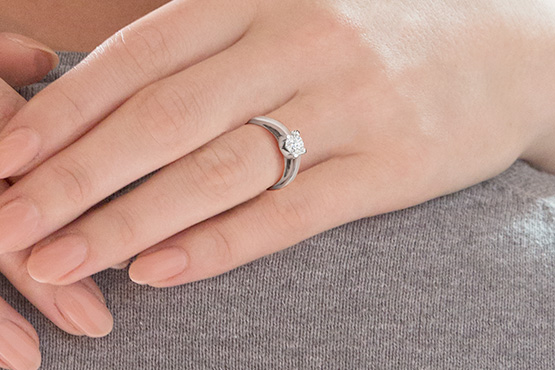Now that you have chosen an engagement ring style and setting, have a think about what the gemstone itself might be.
It is only as recently as the late 1940s that the Diamond became the go-to choice for engagement rings. Before then, it was more usual to have other gemstones – Sapphires, Rubies, and Emeralds were all very popular. More recently, there has been a shift back towards these more colorful gems.
Tanzanite, a relatively new discovery, has also become a popular gemstone for engagement stones, due to its fabulous blue to violet hue, and its association with new beginnings.
If you want a more individual choice, birthstones often feature as engagement gemstones – perhaps consider a setting that combines both of your birth gems for a truly meaningful touch.
Cut
There are a huge array of shapes and cuts available on the market. A round brilliant cut is the most traditional cut for a solitaire, but it is definitely worth having a look at some other options if you’re after something a little bit different:
ROUND CUT
 Round Cut - Will usually produce the most sparkle of any cut. The most traditional cut for a Diamond solitaire engagement ring.
SHOP ROUND CUT ENGAGEMENT RINGS
Round Cut - Will usually produce the most sparkle of any cut. The most traditional cut for a Diamond solitaire engagement ring.
SHOP ROUND CUT ENGAGEMENT RINGS
OVAL CUT
Oval - This shape has many benefits, giving a larger look than a round cut gem of the same size.
CUSHION CUT
 Cushion - A square shape with rounded, softer looking edges, often looks very vintage.
Cushion - A square shape with rounded, softer looking edges, often looks very vintage.
TRILLION CUT
Trillion or Trilliant - The triangle brilliant cut, which can be pointed or soft-edged, an adventurous cut.
EMERALD CUT
Emerald - The classic cut for an Emerald, using its naturally elongated shape. Can be used for other gems too.
ASSCHER CUT
Asscher - Developed by the Asscher Brothers, this cut was en vogue in the 1920s and will give a very authentically vintage feel.
PRINCESS CUT
 Princess - One of the most sophisticated and modern-looking cuts, a more squared version of the cushion cut.
Princess - One of the most sophisticated and modern-looking cuts, a more squared version of the cushion cut.
HEART CUT
Heart - The most romantic cut of all, a heart shape is very difficult to cut in certain stones.
MARQUISE CUT
Marquise - An elongated oval with two tapered ends, named after the smile of the Marquise de Pompadour. An unusual choice, it can leave gemstones vulnerable to damage, so needs more care than some other cuts.
PEAR CUT
 Pear - Said to suit small hands best, the pear shape is a combination of the oval and marquise cuts. The pointed end can be vulnerable to damage if it isn't protected in the setting.
Pear - Said to suit small hands best, the pear shape is a combination of the oval and marquise cuts. The pointed end can be vulnerable to damage if it isn't protected in the setting.
With all of these cuts, look for gemstones that have symmetrical facets and that it reflects light evenly across the surface. Make sure the polish is good, with no scratching and that they have even color, with no light or dark areas. Some gemstones are cut to maximize carat weight, rather than beauty. Look out for gemstones that have ‘fat bottoms’ or ‘fat girdles’ (the widest part of the gem) and that have a bigger carat weight for their size than similar stones. Here at Gemporia, we always cut our gems for beauty rather than carat weight.
Finally, our last guide How to Choose an Engagement Ring Part Five - Final Thoughts, runs through a few final considerations to ensure you have chosen the perfect ring.

